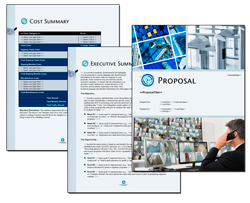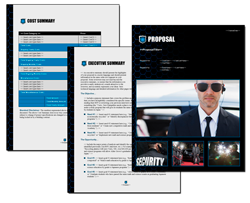
Types of Security Services
Are you a security expert? That category can include many specialties-everything from providing bodyguard services to designing software security programs to selling and installing burglar alarms and security cameras. Security services are expanding to include technology-based threats.
Proposal Kit can create all of the security proposals mentioned here and more. Scroll down for details and popular Proposal Kit packages. Every one of our Security Themed Proposal Packs and Professional Bundle can create your security proposals for these situations.
- Patrol Services: Regularly scheduled or random patrols of property to deter crime and ensure security.
- Access Control: Managing facility access, including checking identification, signing in visitors, and monitoring entry points.
- Event Security: Providing security services for events, including crowd control, access management, and emergency response coordination.
- Alarm Response: Responding to alarms quickly to assess and address potential security breaches or emergencies.
- CCTV Monitoring: Monitoring closed-circuit television systems to prevent theft and vandalism and ensure overall security.
- Executive Protection: Offering personal protection services for executives, VIPs, and others who may face increased security risks.
- Loss Prevention: Implementing strategies and taking actions to prevent theft or loss within retail or corporate settings.
- Mobile Patrols: Using vehicles to patrol and respond to incidents across large areas or multiple sites.
- Fire Watch Services: Providing services to monitor properties for fire hazards, especially in places where the fire alarm system is not operational.
- Armed Security: Employing armed guards to offer a higher level of security where threats may be more severe.
- Unarmed Security: Providing a visible security presence without the use of firearms to deter criminal activity.
- Emergency Response: With trained personnel, prepare for and respond to emergencies, including medical emergencies.
- Concierge Security: This involves combining security services with concierge services for residential or corporate buildings to enhance customer service and security.
- Construction Site Security: Securing construction sites to prevent theft and vandalism and ensure the safety of construction workers.
- Retail Security: Offering specialized services for retail environments to prevent theft, ensure the safety of customers and staff, and manage crowd control.
- Personal Bodyguard Services: Providing close protection services to individuals who require personal security due to their status, occupation, or threats.
- Cybersecurity Monitoring and Response: Identifying and responding to cyber threats in real-time to protect organizational IT infrastructure and data.
- Vulnerability Assessments: Evaluating systems and networks for vulnerabilities that could be exploited by cyber attackers and recommending measures to mitigate risks.
- Incident Response and Recovery: Providing rapid response services to cyber incidents, minimizing damage, and implementing recovery strategies.
- Security Awareness Training: Offering training programs for employees and management on best practices for digital security and how to recognize phishing attempts and other cyber threats.
- Data Protection and Privacy: Implementing measures to protect sensitive data from unauthorized access and ensuring compliance with data protection regulations.
- AI Security: Addressing security threats related to artificial intelligence, including preventing AI-driven attacks.
- Threat Intelligence Services: Gathering and analyzing information on emerging cyber threats to inform security strategies and defenses.
- Penetration Testing: Simulating cyber attacks to test the effectiveness of security measures and identify weaknesses in systems and networks.
- Blockchain Security: Securing blockchain technology applications against attacks and ensuring the integrity of blockchain-based transactions.
- IoT Security: Providing security solutions for Internet of Things (IoT) devices and networks, preventing unauthorized access and data breaches.
- Cloud Security: Protecting cloud-based systems and data from cyber threats, including securing data transfers and ensuring secure cloud storage.
- Identity and Access Management (IAM): Managing user identities and access rights to ensure that only authorized individuals can access sensitive systems and data.
- Endpoint Security: Securing endpoint devices like computers, mobile phones, and IoT devices from being exploited by malicious actors.
- Network Security: Implementing security measures to protect the integrity, confidentiality, and availability of data across network infrastructure.
Why do I need a security services proposal?

You know all about your field. You know your capabilities and what your clients need from you. But do you know how to win new clients and gain more business share? These days, all businesses are clamoring for attention, and there's much competition out there, too. The old business practices of sending out form letters and paying for an ad in the local phone book is probably not the wisest strategy. The best way to succeed in expanding your client base and securing more contracts is to master how to write a business proposal.
What do I include in my security services proposal?
You've never written a business proposal? Don't sweat it. Four elements make up every business proposal. Here's the basic structure:
- Introduce yourself;
- Show that you understand your prospective client's needs;
- Highlight your goods and services and present your costs;
- Persuade the client that your organization is right for the job.
Doesn't sound so tough, does it? You can also get a head start by using pre-designed security proposal templates, samples, and some automation software to help you write your proposal efficiently.
Writing Your Security Proposal
Creating a comprehensive security proposal involves several key sections, which may or may not include:
- Cover letter and title page
- Executive or client summary
- Summary of benefits
- Detailed price breakdown
- Discussion of security issues relevant to the client
- Detailed description of products and services
- A section about your business or organization
Following the four-section structure described above, writing a business proposal for a security-related business will be pretty straightforward. The number of pages in your proposal will vary depending on the complexity of the project you are proposing. An average proposal is five to ten pages long, while a complex proposal could have dozens of pages. A short one might include only an introductory Cover Letter, a Work Order or a Products or Services Provided page, and a Price List.
The secret to creating a successful proposal is tailoring it to the party who will decide whether or not to accept it. Put yourself in the other person's shoes. What does that person or organization need? What are their concerns? If you don't know that party well, you may need to do some research, but it will pay off in creating a customized proposal that is much more likely to succeed than any form letter.

Tailoring a proposal doesn't mean that each page needs to be unique. You will naturally reuse many of the same pages in multiple proposals. However, each proposal should be targeted to the specific client's needs. A proposal is a sales document that aims to persuade potential clients to give you their business. To be persuasive, you must instill trust that you can deliver the goods or services they need, which takes some personalized effort.
Start your proposal by introducing yourself and providing the proposal with a cover letter and title page. Keep your Cover Letter brief:
- Explain who you are.
- Include all relevant contact information.
- Print the letter on your company letterhead.
The Title Page is exactly what it sounds like: a page that introduces your proposal and your project. Some examples might be "Installation and Monitoring of Security Cameras and Alarm Systems for the Ryleston Buildings," "Proposal to Provide Security Services for the Regional Mayors Conference," "Proposed Upgrading of Computer Security for XYX Corporation."
After the introduction comes a client-centered section; here, you will include topics that show your understanding of your potential client. Depending on the complexity of the project you are proposing, you may or may not need to start with a detailed summary (called an Executive Summary for corporate clients or a Client Summary for a less formal project). This client-centered section describes the prospective client's needs, goals, and concerns. This is not yet where you talk about your goods or services. This section is all about your client.
After the client-centered section comes your section and your chance to shine; add pages that describe how you will provide solutions to the client's needs with your goods or services. You'll add pages with titles like Security, Security Plan, Safety Plan, Services Provided, Benefits, Products, Price List, Services Cost Summary, Warranty, Guarantee, and so forth - include all the topics you need to describe precisely what you intend to provide and how much it will cost.
You will need specialized topics that pertain to your particular business. Add pages with details the client will want to know.
For example, a company that sells computer security systems might want to include descriptions of Hardware and Software, an Installation Schedule, Specifications, and Certifications held by its employees.
A bodyguard service will probably need personnel descriptions, details about its Training Plan, Contingency Planning pages, a discussion of Discretion issues, and so forth.
A company selling security cameras and other devices may need to include pages about Equipment, Maintenance, Service Plans, Customer Service, and Warranty or Guarantee pages.
A private investigation service may want to discuss Surveillance, Investigation, Background Checks, Discretion, Confidentiality, and so on.
A federal grant or contract for a security improvement project will require specialized government forms and security proposal templates to ensure compliance with RFP requirements.
A business security proposal may require planning for the business's continuation. Use chapter pages such as Contingency Planning, Disaster Recovery Plan, and Risk Analysis.
Here are some related samples included in every Proposal Pack
- Property Management Services Proposal
- Security Services Proposal
- DOJ Federal Government Grant Proposal
- DOJ Federal Government Grant Proposal #2
- Employee Security Card Sample Proposal
- Business Continuity Services Sample Proposal
- Private Eye Investigation Services Sample Proposal
- Request for Proposal (RFP) Sample
- Security Guard Services Sample Proposal
- Fire and Safety Request for Proposal (RFP) Sample
- Disaster Preparation and Training Sample Proposal
- Security Plan Analysis Document
After you've described your goods and services and costs, the final section comes, where you provide information about your company. Your goal is to conclude your proposal by convincing the prospective client that you can be trusted to deliver the goods or services you have described. You'll add pages like About Us / Company History, Awards and Achievements, Testimonials, References, Qualifications, Capabilities, Our Clients, Experience, and so on. Include everything you need to convince the client that you can do what you've promised.
Wrapping up your security business proposal
That's it! The proposal is written. Now, take a little time to make your proposal visually appealing. You want it to stand out from the competition. Add color and graphics by incorporating your company logo, selecting custom bullet points and fonts, or adding colored page borders. Stay moderate, though - you want to match your business style. Learn how to select colors for a winning business proposal effectively.
 Proposal Pack for Any Business covers this type of proposal and includes samples. There are also some commonly used specialty design themes available:
Proposal Pack for Any Business covers this type of proposal and includes samples. There are also some commonly used specialty design themes available:Photo Design Proposal Packs
Line Art Design Proposal Packs
 Proposal Pack Investigation #1
Proposal Pack Investigation #1 Proposal Pack Justice #1
Proposal Pack Justice #1 Proposal Pack Military #1
Proposal Pack Military #1 Proposal Pack Military #2
Proposal Pack Military #2 Proposal Pack Military #3
Proposal Pack Military #3 Proposal Pack Military #4
Proposal Pack Military #4 Proposal Pack Safety #1
Proposal Pack Safety #1 Proposal Pack Safety #2
Proposal Pack Safety #2 Proposal Pack Safety #3
Proposal Pack Safety #3 Proposal Pack Security #1
Proposal Pack Security #1 Proposal Pack Security #2
Proposal Pack Security #2 Proposal Pack Security #3
Proposal Pack Security #3 Proposal Pack Security #4
Proposal Pack Security #4 Proposal Pack Security #5
Proposal Pack Security #5 Proposal Pack Security #6
Proposal Pack Security #6 Proposal Pack Security #7
Proposal Pack Security #7
Be sure to proofread and spell-check all the pages carefully. If your proposal seems carelessly thrown together, the reader will probably conclude that you're careless, too. It's always hard to spot errors in your own work, so it's a good idea to have someone unfamiliar with your proposal do the final proof. Spell check cannot catch correctly spelled but misused words. If you don't have a proofreader, subscribe to an online grammar checker that will proofread your work.
Save your proposal as a PDF or print it, then deliver it. Although emailing PDF files to clients nowadays is expected, a hand-delivered printed proposal may impress the client more. If the new business is especially valuable to you and you have much competition for work, you should put your best effort into the proposal and delivery.
Compliance and Legal Considerations

Depending on the local laws and regulations and the services being provided, another consideration is highlighting the importance of following legal rules and industry standards to protect the business and maintain customer trust. These may be topics included in the proposal or dealt with separately.
Global and Local Regulations
Detail how your services align with critical data protection laws such as the General Data Protection Regulation (GDPR) for clients in or dealing with the European Union, the California Consumer Privacy Act (CCPA), and other regional laws. Explain how your security measures are designed to ensure the client's compliance with these regulations.
Client Data Security
Describe the methods and technologies you use to secure client data, such as encryption, secure data storage solutions, and regular security audits, to prevent data breaches and ensure privacy.
Industry Standards and Certifications
Explain how your services comply with industry-specific security standards, such as ISO/IEC 27001 for information security management, PCI DSS for payment card industry security, and HIPAA for healthcare privacy and security.
If your company holds any security-related certifications, highlight these as evidence of your commitment to best practices and excellence in security. Detail how these certifications benefit your client by ensuring high-quality and compliant security services.
Customized Compliance Solutions
Emphasize your ability to create customized security plans that meet general compliance requirements and address the client's business's specific legal and regulatory needs. This could include sector-specific regulations, such as financial services laws or healthcare privacy requirements.
Offer ongoing support and consultation services to help clients ensure compliance. This could involve regularly updating security practices in response to new legislation, conducting compliance audits, or offering training sessions for the client's staff.
Risk Management and Liability

Include a section on how your security services help identify and mitigate legal and compliance risks associated with the client's operations. This should cover both physical and digital security risks.
Discuss how employing your security services can reduce the client's liability in case of security incidents. Emphasize your company's expertise in implementing industry-standard security measures to protect against legal action and financial loss.
Key Takeaways
- Each security business proposal will include different pages, and for maximum success, each proposal should be tailored for the party receiving it.
- All security proposals will follow a similar format and structure, and you can reuse some pages, so you'll become more efficient with each proposal.
- You don't need to start from scratch - you can find security proposals for all the pages mentioned here in every Proposal Pack.
- These security proposal templates contain instructions and provide examples of information to include on each proposal page. The packs also contain sample proposals, including samples for various security-related businesses.
- Using Proposal Kit's templates and studying the sample proposals will give you a giant stride toward creating your winning business proposal.



 Cart
Cart
 Are you just looking for a template, sample, or software for your security proposals? Click these links to skip down the page and get right to it.
Are you just looking for a template, sample, or software for your security proposals? Click these links to skip down the page and get right to it.











 Facebook
Facebook YouTube
YouTube X
X Search Site
Search Site